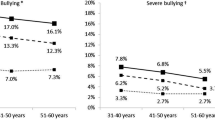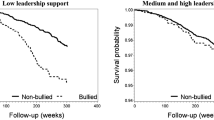Abstract
Aim
This study investigates if non-bullied employees in Work units (WUs) where bullying occur, are more prone to leave the WUs than employees in WUs with no bullying, and if the prevalence of workplace bullying had an impact on leaving the WUs. Leaving the workplace was defined by unemployment or change of workplace at follow-up.
Methods
We had data from 8326 Danish public health invited employees from 302 WUs. Of these 3036 responded to a questionnaire on working conditions and health in 2007. WUs were classified into three categories of WUs: (1) no bullying (0% bullied), (2) moderate prevalence of bullying (< 10% bullied), and (3) high prevalence of bullying (≥ 10% bullied). Bullied respondents were used to classify the WUs and excluded in the analyses.
Results
We found odds ratios (ORs) for unemployment 1 year later of 1.27 [95% CI 0.69–2.37] in WUs with moderate prevalence of bullying and 1.38 [95% CI 0.85–2.23] among employed in WUs with high prevalence of bullying, adjusted for size of WUs, age, sex, and job category. For turnover 1 year later the ORs were 1.27 [95% CI 0.78–2.15] and 1.46 [95% CI 0.99–2.15] in WUs with moderate and high prevalence of bullying, respectively.
Conclusion
We did not find that non-bullied employees leave the WUs with moderate and high prevalence of bullying more than employees in WUs with no bullying behaviour 1 year later. Leaving the workplace tended to be higher among employees in WUs with high prevalence of bullying compared to no and moderate bullying.

Similar content being viewed by others
References
Aquino K, Thau S (2009) Workplace victimization: aggression from the target’s perspective. Annu Rev Psychol 60:717–741
Ariza-Montez A, Leal-Rodriguez AL, Leal-Millan AG (2015) A comparative study of workplace bullying among public and private employees in Europe. J Occup Environ Med 57:695–700
Baillien E, De Witte H (2009) The relationship between the occurrence of conflicts in the work unit, the conflict management styles in the work unit and workplace bullying. Psychologica Belgica 49(4):207
Baillien E, Neyens I, De Witte H (2008) Organizational, team related and job related risk factors for workplace bullying, violence and sexual harassment in the workplace: a qualitative study. Int J Org Behav 13(2):132–146
Balducci C, Fraccaroli F, Schaufeli WB (2011) Workplace bullying and its relation with work characteristics, personality, and post-traumatic stress symptoms: an integrated model. Anxiety Stress Coping 24(5):499–513
Berthelsen M, Skogstad A, Lau B, Einarsen S (2011) Do they stay or do they go? A longitudinal study of intentions to leave and exclusion from working life among targets of workplace bullying. Int J Manpower 32(2):178–193
Branch S, Ramsay S, Barker M (2013) Workplace bullying, mobbing and general harassment: A review. Int J Manage Rev 15(3):280–299
Chu CH, Wodchis WP, McGilton KS (2014) Turnover of regulated nurses in long-term care facilities. J Nurs Manag 22(5):553–562
Clausen T, Hogh A, Borg V (2012) Acts of offensive behaviour and risk of long-term sickness absence in the Danish elder-care services: a prospective analysis of register-based outcomes. Int Arch Occup Environ Health 85(4):381–387
Clausen T, Hogh A, Carneiro IG, Borg V (2013) Does psychological well-being mediate the association between experiences of acts of offensive behaviour and turnover among care workers? A longitudinal analysis. J Adv Nurs 69(6):1301–1313
Clausen T et al (2016) Exposure to negative acts and risk of turnover: a study of a register-based outcome among employees in three occupational groups. Int Arch Occup Environ Health 89(8):1269–1278. https://doi.org/10.1007/s00420-016-1161-3
Clausen T et al (2019) Does leadership support buffer the effect of workplace bullying on the risk of disability pensioning? An analysis of register-based outcomes using pooled survey data from 24,538 employees. Int Arch Occup Environ Health 97:1–8
Dellve L, Lagerström M, Hagberg M (2003) Work-system risk factors for permanent work disability among home-care workers: a case-control study. Int Arch Occup Environ Health 76(3):216–224
Djurkovic N, McCormack D, Casimir G (2008) Workplace bullying and intention to leave: the moderating effect of perceived organisational support. Hum Resour Manage J 18(4):405–422
Dollard MF, Dormann C, Tuckey MR, Escartín J (2017) Psychosocial safety climate (PSC) and enacted PSC for workplace bullying and psychological health problem reduction. Eur J Work Org Psychol 26(6):844–857
Einarsen S (2000) Harassment and bullying at work: a review of the Scandinavian approach. Aggress Violent Behav 5(4):379–401
Einarsen S, Raknes BI (1997) Harassment in the workplace and the victimization of men. Viol Victims 12(3):247–263
Glambek M, Matthiesen SB, Hetland J, Einarsen S (2014) Workplace bullying as an antecedent to job insecurity and intention to leave: a 6-month prospective study. Hum Resour Manage J 24(3):255–268
Glambek M, Skogstad A, Einarsen S (2015) Do the bullies survive? A five-year, three-wave prospective study of indicators of expulsion in working life among perpetrators of workplace bullying. Ind Health. https://doi.org/10.2486/indhealth.2015-0075
Glasø L, Bele E, Nielsen MB, Einarsen S (2011) Bus drivers’ exposure to bullying at work: an occupation-specific approach. Scand J Psychol. https://doi.org/10.1111/j.1467-9450.2011.00895
Grynderup MB et al (2017) The associations between workplace bullying, salivary cortisol, and long-term sickness absence: a longitudinal study. BMC Publ Health 17(1):710
Hansen ÅM (2017) Workplace Bullying, Stress Response and Long-term Sickness Absence-Exploring Mechanisms: Results from Six Cohort Studies. University of Copenhagen, Faculty of Health and Medical Sciences
Hansen Å, Grynderup MB (2017) Do work units where bullying is present have more long-term sickness absence? EAWOP 2017
Hansen ÅM, Høgh A, Persson R, Karlson B, Garde AH, Ørbæk P (2006) Bullying at work, health outcomes, and physiological stress response. J Psychosom Res 60:63–72
Hansen Å, Grynderup M, Bonde J (2018) Does workplace bullying affect long-term sickness absence among coworkers? … of occupational and …
Hauge LJ, Skogstad A, Einarsen S (2007) Relationships between stressful work environments and bullying: Results of a large representative study. Work Stress 21(3):220–242
Hogh A, Mikkelsen EG, Hansen ÅM (2010) Individual consequences of workplace bullying/mobbing. In: Einarsen S, Hoel H, Zapf D, Cooper CL (eds) Bullying and harassment in the workplace: developments in theory, research, and practice. CRC Press, Boca Raton, pp 107–128
Hogh A, Hoel H, Carneiro IG (2011) Bullying and employee turnover among healthcare workers: a three-wave prospective study. J Nurs Manag 19(6):742–751
Holtom BC, Mitchell TR, Lee TW, Eberly MB (2008) 5 turnover and retention research: a glance at the past, a closer review of the present, and a venture into the future. Acad Manage Ann 2(1):231–274
Houshmand M, O’Reilly J, Robinson S, Wolff A (2012) Escaping bullying: The simultaneous impact of individual and unit-level bullying on turnover intentions. Hum Relat 65(7):901–918
Work and Health in Denmark (2018) https://nfa.dk/da/Arbejdsmiljoedata/Arbejdsmiljo-i-Danmark/Arbejdsmiljo-og-helbred-i-Danmark
Kaerlev L et al (2011) Are risk estimates biased in follow-up studies of psychosocial factors with low base-line participation? BMC Public Health 11:539
Kivimaki M et al (2005) Justice at work and reduced risk of coronary heart disease among employees: the Whitehall II Study. Arch Intern Med 165(19):2245–2251
Kolstad HA et al (2011) Job strain and the risk of depression: is reporting biased? Am J Epidemiol 173(1):94–102
Lange S, Burr H, Conway PM, Rose U (2019) Workplace bullying among employees in Germany: prevalence estimates and the role of the perpetrator. Int Arch Occup Environ Health 92(2):237–247
Leach LS, Poyser C, Butterworth P (2016) Workplace bullying and the association with suicidal ideation/thoughts and behaviour: a systematic review. Occup Environ Med:oemed-2016-103726
Moreno-Jimenez B, Diaz-Gracia L (2012) Workplace aggression and intention to quit: Examining the mediating role of job satisfaction. DE PSICOLOGÍA 29(2):125–135
Mortensen EL et al (2014) The relationship between cognitive ability and demographic variables in late midlife. J Aging Health 26:37–53
Nabe-Nielsen K et al (2017) The role of psychological stress reactions in the longitudinal relation between workplace bullying and turnover. J Occup Environ Med 59(7):665–672
Nielsen MB, Notelaers G, Einarsen S (2011) Measuring exposure to workplace bullying. In: Einarsen S, Hoel H, Zapf D, Cooper CL (eds) Bullying and harassment in the workplace. Taylor & Francis Group, Boca Raton, pp 149–174
Norrbäck M, Tynelius P, Ahlström G, Rasmussen F (2019) The association of mobility disability and obesity with risk of unemployment in two cohorts from Sweden. BMC Public Health 19(1):347
Nygård JF, Klungsøyr O, Sandanger I, Svensson E (2009) Selection effects in psychiatric epidemiology. Soc Psychiatry Psychiatr Epidemiol 44(10):881–886
Ortega A, Christensen KB, Hogh A, Rugulies R, Borg V (2010) One year prospective study on the effect of workplace bullying on long-term sickness absence. J Nurs Manage 19:752–759
Pedersen J, Villadsen E, Burr H, Martin M, Nielsen MD, Meinertz L (2011) The Danish Register of Sickness absence compensation benefits and Social transfer payments - RSS., Copenhagen, p 1–56
Pejtersen J, Kristensen TS, Bjorner JB, Borg V, Christensen KB (2010) The second version of the Copenhagen Psychosocial Questionnaire. Scand J Public Health 38(suppl 3):8–24
Pihl P, Albertsen K, Hogh A, Andersen LPS (2017) Social capital and workplace bullying. Work 57(4):535–545
Salin D (2003) Ways of explaining workplace bullying: a review of enabling, motivating and precipitating structures and processes in the work environment. Hum Relat 56(10):1213–1232
Salin D (2008) The prevention of workplace bullying as a question of human resource management: measures adopted and underlying organizational factors. Scand J Manage 24:221–231
Salin D (2015) Risk factors of workplace bullying for men and women: The role of the psychosocial and physical work environment. Scand J Psychol 56(1):69–77
Salin D, Hoel H (2011) Organisational causes of workplace bullying. In: Einarsen S, Hoel H, Zapf D, Cooper CL (eds) Bullying and harassment in the workplace: developments in theory, research, and practice, vol 2. CRC Press, Boca Raton, pp 227–243
Skogstad A, Einarsen S, Torsheim T, Aasland MS, Hetland H (2007) The destructiveness of laissez-faire leadership behavior. J Occup Health Psychol 12(1):80–92
Sterud T, Tynes T (2013) Work-related psychosocial and mechanical risk factors for low back pain: a 3-year follow-up study of the general working population in Norway. Occup Environ Med 70(5):296–302
Stromholm T, Pape K, Ose SO, Krokstad S, Bjorngaard JH (2015) Psychosocial working conditions and sickness absence in a general population: a cohort study of 21,834 workers in Norway (The HUNT Study). J Occup Environ Med 57(4):386–392
Tsuno K et al (2015) Socioeconomic determinants of bullying in the workplace: a national representative sample in Japan. PLoS ONE 10(3):e0119435
Vartia M (1996) The sources of bullying–psychological work environment and organizational climate. Eur J Work Org Psychol 5(2):203–214
Zapf D, Einarsen S, Hoel H, Vartia M (2003) Empirical findings on bullying in the workplace. In: Einarsen S, Hoel H, Zapf D, Cooper CL (eds) Bullying and emotional abuse in the workplace international perspectives in research and practice, 1st edn. Taylor and Francis, London and New York, pp 103–126
Acknowledgements
The study was funded by The Danish Working Environment Research Fund (Grant Number 20130023294) and The Danish Council for Independent Research (Grant Number 1319-00092).
Funding
The funding organs played no role in the collection of data, formulation of study hypothesis, analyses, or interpretation of findings.
Author information
Authors and Affiliations
Corresponding author
Ethics declarations
Conflicts of interest
The authors declare that they have no conflict of interests.
Additional information
Publisher's Note
Springer Nature remains neutral with regard to jurisdictional claims in published maps and institutional affiliations.
Rights and permissions
About this article
Cite this article
Hansen, Å.M., Grynderup, M.B., Clausen, T. et al. Labour market affiliation among non-bullied colleagues at work units with reported bullying. Int Arch Occup Environ Health 94, 547–556 (2021). https://doi.org/10.1007/s00420-020-01604-8
Received:
Accepted:
Published:
Issue Date:
DOI: https://doi.org/10.1007/s00420-020-01604-8




